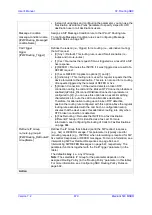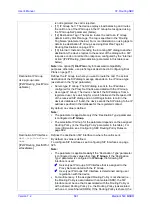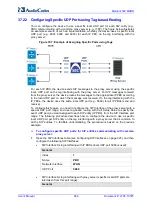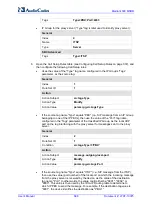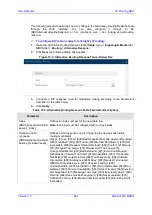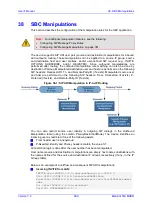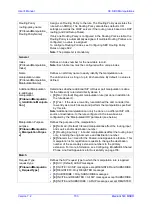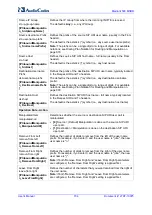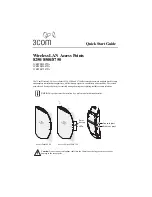
Version 7.2
693
Mediant 500 MSBR
User's Manual
37. Routing SBC
Typically, assigning a Routing Policy to a Classification rule is not required, as when an
incoming call is classified it uses the Routing Policy associated with the SRD to which it
belongs. However, if a Routing Policy is assigned to a Classification rule, it overrides the
Routing Policy assigned to the SRD. The option to assign Routing Policies to Classification
rules is useful in deployments requiring different routing and manipulation rules for specific
calls pertaining to the
same
SRD. In such scenarios, you need to configure multiple
Classification rules for the same SRD, where for some rules no Routing Policy is assigned
(i.e., the SRD's assigned Routing Policy is used) while for others a different Routing Policy
is specified to override the SRD's assigned Routing Policy.
In multi-tenant environments employing multiple SRDs and Routing Policies, the IP Groups
that can be used in routing rules (in the IP-to-IP Routing table) are as follows:
If the Routing Policy is assigned to only one SRD and the SRD is an Isolated SRD, the
routing rules of the Routing Policy can be configured with IP Groups belonging to the
Isolated SRD and IP Groups belonging to all Shared SRDs.
If the Routing Policy is assigned to a Shared SRD, the routing rules of the Routing
Policy can be configured with any IP Group (i.e., belonging to Shared and Isolated
SRDs). In effect, the Routing Policy can include routing rules for call routing between
Isolated SRDs.
If the Routing Policy is assigned to multiple SRDs (Shared and/or Isolated), the routing
rules of the Routing Policy can be configured with IP Groups belonging to all Shared
SRDs as well as IP Groups belonging to Isolated SRDs that are assigned the Routing
Policy.
To facilitate the configuration of routing rules in the IP-to-IP Routing table through the Web
interface, only the permitted IP Groups (according to the above) are displayed as optional
values.
The general flow for processing the call for multi-tenant deployments and Routing Policies
is as follows:
1.
Using the Classification table, the device classifies the incoming call to an IP Group,
based on the SIP Interface on which the call is received. Based on the SIP Interface,
the device associates the call to the SRD that is assigned to the SIP Interface.
2.
Once the call has been successfully classified to an IP Group, the Routing Policy
assigned to the associated SRD is used. However, if a Routing Policy is configured in
the Classification table, it overrides the Routing Policy assigned to the SRD.
3.
The regular manipulation (inbound and outbound) and routing processes are done
according to the associated Routing Policy.
Note:
•
The Classification table is used only if classification by registered user in the
device's users registration database or by Proxy Set fails.
•
If the device receives incoming calls (e.g., INVITE) from users that have already
been classified and registered in the device's registration database, the device
ignores the Classification table and uses the Routing Policy that was determined
for the user during the initial classification process.
The following procedure describes how to configure Routing Policies rules through the
Web interface. You can also configure it through ini file (SBCRoutingPolicy) or CLI
(configure voip > sbc routing sbc-routing-policy).
To configure a Routing Policy rule:
1.
Open the Routing Policies table (
Setup
menu >
Signaling & Media
tab >
SBC
folder
>
Routing
>
Routing Policies
).
Summary of Contents for Mediant 500 MSBR
Page 2: ......
Page 33: ...Part I Getting Started with Initial Connectivity ...
Page 34: ......
Page 36: ...User s Manual 36 Document LTRT 10375 Mediant 500 MSBR This page is intentionally left blank ...
Page 40: ...User s Manual 40 Document LTRT 10375 Mediant 500 MSBR This page is intentionally left blank ...
Page 45: ...Part II Management Tools ...
Page 46: ......
Page 48: ...User s Manual 48 Document LTRT 10375 Mediant 500 MSBR This page is intentionally left blank ...
Page 115: ...Part III General System Settings ...
Page 116: ......
Page 132: ...User s Manual 132 Document LTRT 10375 Mediant 500 MSBR This page is intentionally left blank ...
Page 137: ...Part IV General VoIP Configuration ...
Page 138: ......
Page 290: ...User s Manual 290 Document LTRT 10375 Mediant 500 MSBR This page is intentionally left blank ...
Page 306: ...User s Manual 306 Document LTRT 10375 Mediant 500 MSBR This page is intentionally left blank ...
Page 380: ...User s Manual 380 Document LTRT 10375 Mediant 500 MSBR This page is intentionally left blank ...
Page 454: ...User s Manual 454 Document LTRT 10375 Mediant 500 MSBR This page is intentionallty left blank ...
Page 455: ...Part V Gateway Application ...
Page 456: ......
Page 460: ...User s Manual 460 Document LTRT 10375 Mediant 500 MSBR This page is intentionally left blank ...
Page 484: ...User s Manual 484 Document LTRT 10375 Mediant 500 MSBR This page is intentionally left blank ...
Page 494: ...User s Manual 494 Document LTRT 10375 Mediant 500 MSBR This page is intentionally left blank ...
Page 625: ...Part VI Session Border Controller Application ...
Page 626: ......
Page 654: ...User s Manual 654 Document LTRT 10375 Mediant 500 MSBR This page is intentionally left blank ...
Page 656: ...User s Manual 656 Document LTRT 10375 Mediant 500 MSBR This page is intentionally left blank ...
Page 741: ...Part VII Cloud Resilience Package ...
Page 742: ......
Page 751: ...Part VIII Data Router Configuration ...
Page 752: ......
Page 753: ......
Page 754: ......
Page 756: ...User s Manual 756 Document LTRT 10375 Mediant 500 MSBR This page is intentionally left blank ...
Page 757: ...Part IX Maintenance ...
Page 758: ......
Page 834: ...User s Manual 834 Document LTRT 10375 Mediant 500 MSBR This page is intetnionaly left blank ...
Page 837: ...Part X Status Performance Monitoring and Reporting ...
Page 838: ......
Page 848: ...User s Manual 848 Document LTRT 10375 Mediant 500 MSBR This page is intentionally left blank ...
Page 852: ...User s Manual 852 Document LTRT 10375 Mediant 500 MSBR This page is intentionally left blank ...
Page 854: ...User s Manual 854 Document LTRT 10375 Mediant 500 MSBR This page is intentionally left blank ...
Page 878: ...User s Manual 878 Document LTRT 10375 Mediant 500 MSBR This page is intentionally left blank ...
Page 880: ...User s Manual 880 Document LTRT 10375 Mediant 500 MSBR This page is intentionally left blank ...
Page 926: ...User s Manual 926 Document LTRT 10375 Mediant 500 MSBR This page is intentionally left blank ...
Page 927: ...Part XI Diagnostics ...
Page 928: ......
Page 950: ...User s Manual 950 Document LTRT 10375 Mediant 500 MSBR This page is intentionally left blank ...
Page 954: ...User s Manual 954 Document LTRT 10375 Mediant 500 MSBR This page is intentionally left blank ...
Page 956: ...User s Manual 956 Document LTRT 10375 Mediant 500 MSBR This page is intentionally left blank ...
Page 958: ...User s Manual 958 Document LTRT 10375 Mediant 500 MSBR This page is intentionally left blank ...
Page 974: ...User s Manual 974 Document LTRT 10375 Mediant 500 MSBR This page is intentionally left blank ...
Page 976: ...User s Manual 976 Document LTRT 10375 Mediant 500 MSBR This page is intentionally left blank ...
Page 977: ...Part XII Appendix ...
Page 978: ......
Page 982: ...User s Manual 982 Document LTRT 10375 Mediant 500 MSBR This page is intentionally left blank ...

